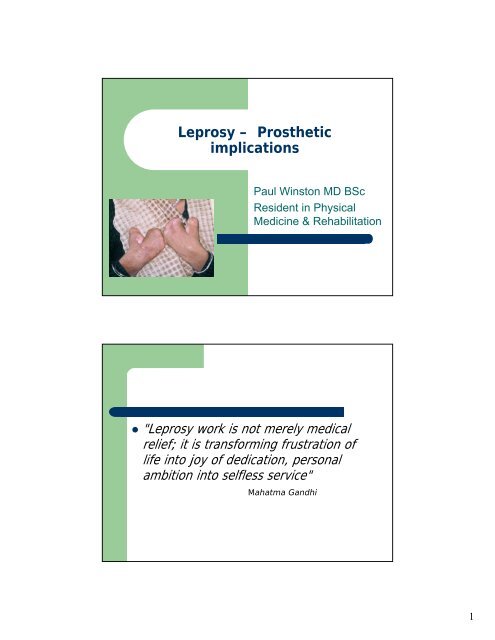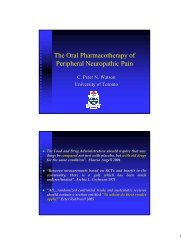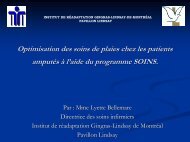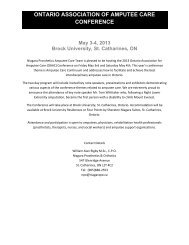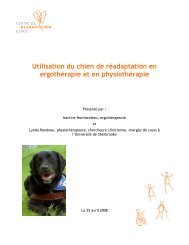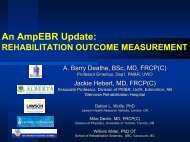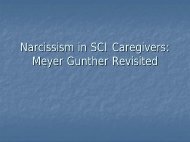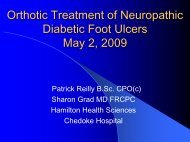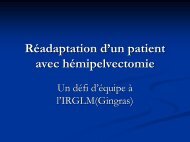Leprosy â Prosthetic implications
Leprosy â Prosthetic implications
Leprosy â Prosthetic implications
Create successful ePaper yourself
Turn your PDF publications into a flip-book with our unique Google optimized e-Paper software.
<strong>Leprosy</strong> – <strong>Prosthetic</strong><br />
<strong>implications</strong><br />
Paul Winston MD BSc<br />
Resident in Physical<br />
Medicine & Rehabilitation<br />
• "<strong>Leprosy</strong> work is not merely medical<br />
relief; it is transforming frustration of<br />
life into joy of dedication, personal<br />
ambition into selfless service"<br />
Mahatma Gandhi<br />
1
Objectives<br />
• A couple of cases<br />
• Infectious agent<br />
• Presentation<br />
• Impact on nerves, bones<br />
• Look at Cases in Toronto<br />
• <strong>Prosthetic</strong> devices<br />
• Mention of the Foot<br />
• Case quiz<br />
• Encourage a field trip<br />
2
Case 1. 38 M from Viet Nam.<br />
• Left BKA – old prosthesis, choked, swollen.<br />
• Note skin lesions and hand involvement<br />
Case 2 – 40 M from Gambia<br />
• Age 20 presented with ulceration over lateral<br />
malleolus. Subsequent foot drop due to peroneal<br />
nerve neuropathy. No other findings.<br />
3
Why this subject in 2006<br />
• We do have patients with leprosy.<br />
• Multicultural society<br />
• Long history for P & O<br />
What is <strong>Leprosy</strong>?<br />
• Chronic infectious granuloma forming disease<br />
caused by Mycobacterium Leprae<br />
(a bacillis similar to TB)<br />
• A disease of peripheral nerves and skin, only<br />
bacillis to target nerves.<br />
• Upper Respiratory Tract, eyes, testes, organs<br />
and bone.<br />
4
History of <strong>Leprosy</strong>- Hansen’s Disease<br />
• First written records in 600 B.C.<br />
• Hansen -M.leprae 1 st bacterium described- 1873<br />
• Untreatable until 1940’s with sulpha antibiotics<br />
• Epidemic in Europe in 12-13th century.<br />
• Today 1.2 million mostly, Asia, Africa,<br />
S.America.<br />
5
In North America<br />
• 136-187 cases per year in U.S.<br />
• Endemic in Texas and Arkansas in armadillos.<br />
• Leper colony in Canada 1891-1957<br />
• We will look at Toronto<br />
M leprae – Can I catch it?<br />
• Spread in aerosolized droplets, or direct skin.<br />
• Slowest known reproduction - 2 weeks<br />
(most 2 minutes)<br />
• Exposure – 2-4 years for effects.<br />
• Incubation weeks--> 30 years!<br />
• Never cultured in vitro<br />
6
Presentation<br />
• Infects skin and peripheral nerve fibres of dermis.<br />
• Multiply best in cool regions, face, limbs. Superficial<br />
nerves<br />
• Presents as a solitary macule, hypopigmented,<br />
alteration of sensation, due to bodies inflammatory<br />
reaction to the infection.<br />
• Indeterminate - Africa 70% heal.<br />
Wide spectrum of effect, no<br />
immunity to violent response.<br />
• Tuberculoid – Very active immune response, few<br />
bacilli left (not detectable levels)<br />
– Affects a few peripheral nerves, adjacent skin,<br />
tuberculoid granuloma<br />
• Lepromatous - host lacks resistance, all tissues<br />
affected, forms granulomas. 10 9 bacilli/g tissue<br />
• Borderline - between tuberculoid and<br />
lepromatous<br />
7
Tuberculoid - Well developed cell<br />
mediated immunity.<br />
• Usually a few areas of skin and Large Nerves often<br />
solitary and well defined<br />
• N. thick from infiltrate, anesthesia,<br />
• Wasting from motor n,<br />
• Autonomic damage, cyanotic and impaired sweating.<br />
• May heal spontaneously<br />
8
Presentation<br />
• Usually, skin lesion, may have for years with no<br />
change dry skin.<br />
• Gradual numbness, don’t know until burn, cut<br />
• Weakness, ie, ulner palsy, foot drop, facial palsy,<br />
wasting and weakness.<br />
• Pain – Neuritis, single nerve first<br />
• Eyes - iridocyclitis (uveitis)<br />
• Nose – epistaxis<br />
9
Lepromatous – Host Overwhelmed<br />
• Chronic<br />
• No cell mediated immunity<br />
• Enormous bacilli growth.<br />
• Not localized, blood to all areas, skin nerves,<br />
URI, nose, testes, organs.<br />
• Starts as a small macule then symmetrical<br />
lesions all over body.<br />
Presentation of Lepromatous<br />
• Sensory loss to extensor surfaces, muscle weakness,<br />
intrinsics first.<br />
• Waxy skin, folds of skin lion-like eyes (Leonine)<br />
• Nasal stuffiness, epistaxis, perforation,<br />
• Impaired sweating<br />
• Feet and fingers, osteoporosis, #, edema<br />
10
Bones & Nerves affected<br />
• Phalanges, replaces marrow.<br />
• Cortical - osteoporosis and #’s<br />
• Lose pin prick, pain and temp. Glove in stocking<br />
• later light touch-->deep p-->tot. anesth.<br />
• Ulnar, median, radial, posterior tibial and facial<br />
• Eventually motor is affected<br />
11
Superficial sites, nerve trunks are cooler,<br />
traumatized, anatomically constricted<br />
■ ulnar nerve - medial epicondyle of the humerus,<br />
■ median nerve at the wrist,<br />
■ supeficial peroneal nerve at the neck of the fibula,<br />
■ posterior tibial nerve behind and inferior to the<br />
medial maleolus, - claw toe<br />
■radial nerve in the humeral groove posterior to the<br />
deltoid insertion – loss of extensors.<br />
Lepromatous damage<br />
• Invades the eye. Hazy<br />
cornea, keratitis.<br />
• acute iridocylitis<br />
• severe glaucoma<br />
• 5th N. anesthetic cornea, 7th<br />
lagopthalmos, and intrinsic m.<br />
weakness.<br />
12
Nose and throat<br />
• Muscle wasting and<br />
weakness.<br />
• Bones and Cartilage<br />
• Us. nasal bones and<br />
phalanges<br />
• Collapse of nose, alveolar<br />
process, teeth (maggots)<br />
• Invades larynx<br />
change in voice -<br />
feminization<br />
13
184 Cases in Toronto<br />
• TGH - 1979 –2002, 80% of Canada<br />
• Symptoms mean 4.8 years before presenting<br />
• 1/3 had sensory nerve involvement<br />
• ¼had motor<br />
• Origin, India, Philippines, Viet Nam<br />
14
Motor involvement<br />
Ulnar 15/80 8.3%<br />
Median and Ulnar 12/180 6.7%<br />
22% had lower extremity motor involvement<br />
Common Peroneal 16.2%<br />
15
Finally to <strong>Prosthetic</strong>s<br />
• Usually in poorest places in the<br />
world.<br />
• Using common, cheap material.<br />
• Much of the diabetes<br />
technology is thankful.<br />
Upper Extremity<br />
• Loss of hand function is more common<br />
• Very gradual compared to other neuropathy<br />
• Digit absorption is slow – very adaptable<br />
16
Breakdown<br />
• Most common grip is a lateral pinch.<br />
• Skin breaks down at maximal stress point.<br />
• Clawed Stump calluses will worsen.<br />
• Infected wounds.<br />
Approach to hand<br />
• Arora et al Indian J. Occupational Therapy<br />
• N=10<br />
• >50% absorption of thumb, and >2 fingers.<br />
• Compared 3 grasps and 3 pinches.<br />
• Fitted – partial hand prosthesis<br />
• Used GPAS Scale.<br />
17
• Easy fit<br />
thermoplastic<br />
• Thumb – post &<br />
base<br />
• Base over thumb<br />
base and thenar<br />
muscles.<br />
• Anchored with<br />
Velcro.<br />
18
Results<br />
• Before Prosthesis<br />
• All ten, side pinch &<br />
hook, 2 – cylindrical.<br />
• Post<br />
• 7 pulp pinch, 9 tripod,<br />
all cylindrical, 5<br />
spherical<br />
Modulan Grip Aid by Ciba Geigy<br />
• Epoxy two resins – rapid, cheap individual<br />
• Patient present, molded to handle or tool<br />
• Grasps device to shape – 12 hours.<br />
19
Care of the foot in <strong>Leprosy</strong><br />
• Too broad for this talk.<br />
• Anesthesia.<br />
• Motor paralysis foot drop, claw toe<br />
• Charcot foot<br />
• Auto-amputation<br />
• Absorption, bony changes and fractures.<br />
• Impaired sweating – dry cracked.<br />
20
A few castings…..<br />
Lower Extremity Amputation<br />
• Leg and foot spared at all costs.<br />
• Do not believe it will be better with<br />
out it.<br />
• Anesthetic patient with poor hand<br />
function.<br />
• Compared to traumatic amputees,<br />
much more difficult, often discarded.<br />
• Goal is to preserve stump with foot<br />
wear, orthoses as long as possible.<br />
22
Indications for amputation<br />
• Flail Leg<br />
• Fixed deformity<br />
• Cancerous conversion<br />
• Non-healing ulcers<br />
• Majority are BKA<br />
Wound Care Guide for People affected by leprosy. A guide for low<br />
resource situations. Hugh Cross. ALM<br />
The $28 Foot - Jaipur<br />
• World’s poorest countries cannot afford imports<br />
• 1971 by Sethi and Chandra.<br />
• Light weight, for multiple usage in bare footed<br />
or sandaled individual.<br />
• Climb trees, ride bikes, squat.<br />
• Made of local materials, quick.<br />
• Multi-axial.<br />
23
The Jaipur Limb.<br />
• Most similar to a SAFE (stationary ankle flexible endoskeleton)<br />
• 12–15 cm high<br />
• Very fexible keel<br />
• multi-axial foot ankle system allows for ankle, midfoot,<br />
and forefoot motion.<br />
• Made from a wood supramalleolar block attached to<br />
a prosthetic shank<br />
• “Microcellular rubber calcaneal, midfoot, and<br />
phalangeal "bones" secured with adhesive cord or<br />
tape…encased in rubber vulcanized in premade foot<br />
molds.”<br />
<strong>Prosthetic</strong> feet for low-income countries. Craig. JPO 2005<br />
Microcellular Rubber – Or a Car Tire<br />
24
The Jaipur foot manual.<br />
http://www.mobility-india.org/download/Jaipur_Foot_manual.pdf<br />
• Ankle block. Short wooden keel allows for<br />
dorsiflexion and plantarflexion.<br />
• MCR heel block allows torsion and deflection for<br />
squatting and uneven ground. Absorbs shock.<br />
• Forefoot block stiff MCR to allow natural toe<br />
movements. Toes each separate MCR<br />
• External cover, vulcanized rubber, natural look,<br />
durable water proof.<br />
25
Jaipur Limb<br />
• Made of high density polyethylene and pipes<br />
(often PVC)<br />
• Once open to contain different size stumps<br />
• Now total contact thermoplastics.<br />
• Endoskeletal with nylon knee joint.<br />
Case Number 1<br />
• West Africa, presented with infected<br />
malleolus.<br />
• Skin changes<br />
• One large nerve and numbness<br />
• Treated quickly.<br />
• Diagnosis?<br />
26
Case 2<br />
• Male from Viet Nam<br />
• Skin lesions, shortened phalanges.<br />
• Waxy skin<br />
• BKA<br />
• Diagnosis<br />
Summary<br />
• Not so rare<br />
• Wide spectrum of disease<br />
• You are not at risk for infection<br />
• Prosthetist is a great friend<br />
• $60 BKA prosthesis!!!!!!!!!!!!!!!!!!!!!!!!!!!!!!!<br />
• Volunteer at a leprosy hospital.<br />
27


